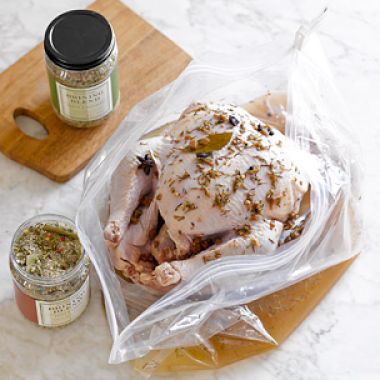Brining

A traditional method of preserving foods before the days of refrigeration, brining is a cooking technique that is regaining popularity. Chefs and home cooks alike are discovering that a good brine bath adds flavor and juiciness to pork, chicken, turkey and even shrimp. After the food is brined, it is then roasted or grilled.
A brine penetrates into food much more deeply than a marinade. Water from the brine enters each meat cell, making the meat juicier while infusing it with flavor. When cooked, the meat or poultry will not necessarily taste salty; it will just taste delicious.
To make a basic brine, stir in 1/4 cup kosher salt for every 4 cups of liquid. (The salt should be kosher salt, which does not contain additives.) You can use water only or mix in other flavorful liquids, such as orange juice, apple cider or wine. Brown sugar, lemon zest, garlic, ginger, sage, rosemary and cinnamon sticks are just a few popular flavoring ingredients. Heating the liquids helps to dissolve the salt and meld the flavors, but be sure to cool the brine completely before adding meat, poultry or fish.
Submerge the food completely in the brine, using nonreactive containers or sealable plastic bags for smaller cuts, or a stainless-steel stockpot or clean plastic bin for large roasts and whole poultry. Then cover and refrigerate.
Whole shrimp require only 30 to 45 minutes of brining. Individual cuts, such as pork chops or chicken breasts, need 2 to 4 hours. A pork tenderloin can be brined overnight, while a whole turkey is best after 24 hours of brining. Always discard brine solutions; do not reuse them.
Adapted from Williams-Sonoma Kitchen Companion,(Time-Life Books, 2000).